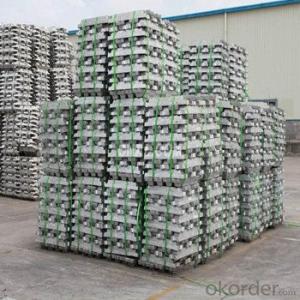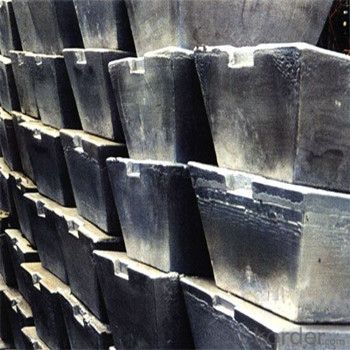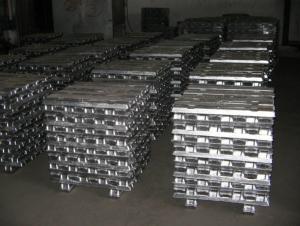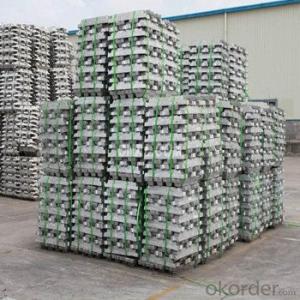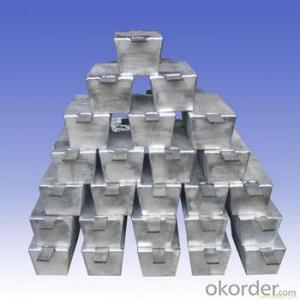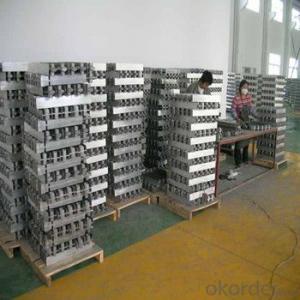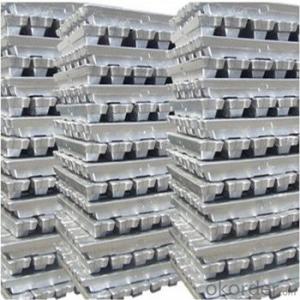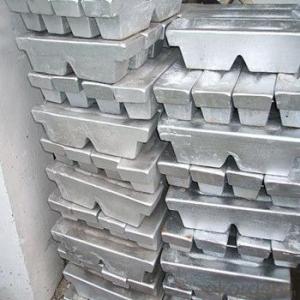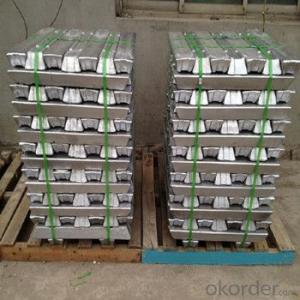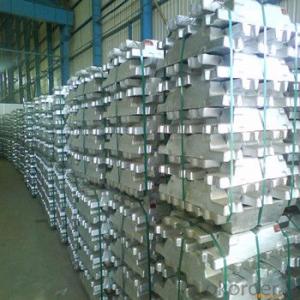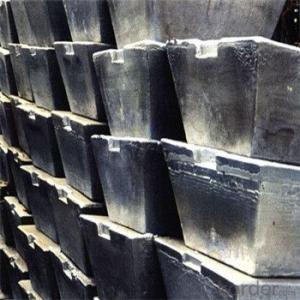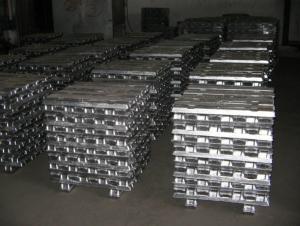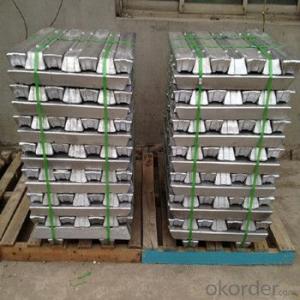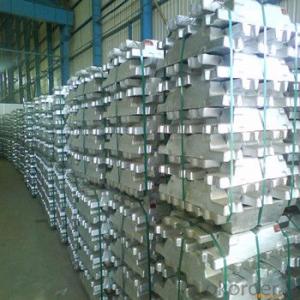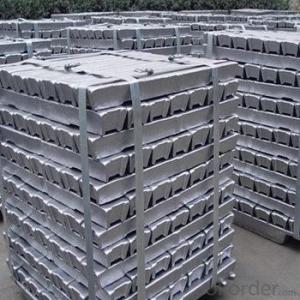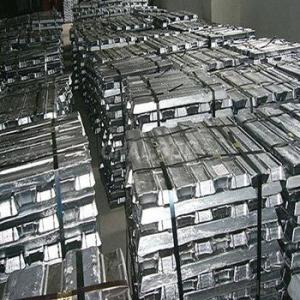Aluminum Ingot 99.7% Hot Selling With Best Price
- Loading Port:
- China main port
- Payment Terms:
- TT OR LC
- Min Order Qty:
- 1000 m.t
- Supply Capability:
- 10000 m.t/month
OKorder Service Pledge
OKorder Financial Service
You Might Also Like
Pure Aluminum Ingot Used for Industry
1.Structure of Aluminum Ingot Description
An ingot is a piece of material, usually metal, that is cast into a shape suitable for further processing. Insteelmaking, it is the first step among semi-finished casting products. Ingots usually require a second procedure of shaping, such as cold/hot working, cutting, or milling to produce a useful final product. Non-metallic and semiconductor materials prepared in bulk form may also be referred to as ingots, particularly when cast by mold based methods.
2.Main Features of the Aluminum Ingot
•High Purity
•High strength
•Fast melting
•Best price
•Good after-service
3. Aluminum Ingot Images
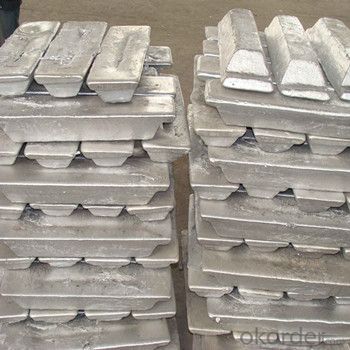
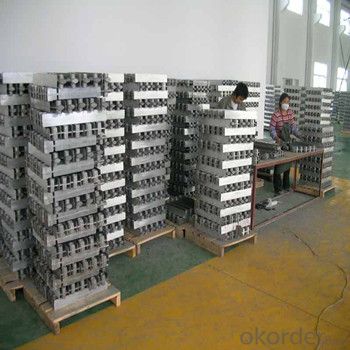
4. Aluminum Ingot Specification
Grade | Chemical Composition % | |||||||||
Al≥ | impurities ≤ | |||||||||
Si | Fe | Cu | Ga | Mg | Zn | Mn | others | Sum | ||
Al99.9 | 99.90 | 0.50 | 0.07 | 0.005 | 0.02 | 0.01 | 0.025 | - | 0.010 | 0.10 |
Al99.85 | 99.85 | 0.80 | 0.12 | 0.005 | 0.03 | 0.02 | 0.030 | - | 0.015 | 0.15 |
Al99.7 | 99.70 | 0.10 | 0.20 | 0.010 | 0.03 | 0.02 | 0.030 | - | 0.030 | 0.30 |
Al99.6 | 99.60 | 0.16 | 0.25 | 0.010 | 0.03 | 0.03 | 0.030 | - | 0.030 | 0.40 |
Al99.5 | 99.50 | 0.22 | 0.30 | 0.020 | 0.03 | 0.05 | 0.050 | - | 0.030 | 0.50 |
Al99.00 | 99.00 | 0.42 | 0.50 | 0.020 | 0.03 | 0.05 | 0.050 | - | 0.050 | 1.00 |
5.FAQ of Aluminum Ingot
We have organized several common questions for our clients,may help you sincerely:
①How about your company?
A world class manufacturer & supplier of castings forging in carbon steel and alloy steel,is one of the large-scale professional investment casting production bases in China,consisting of both casting foundry forging and machining factory. Annually more than 8000 tons Precision casting and forging parts are exported to markets in Europe,America and Japan. OEM casting and forging service available according to customer’s requirements.
②How to guarantee the quality of the products?
We have established the international advanced quality management system,every link from raw material to final product we have strict quality test;We resolutely put an end to unqualified products flowing into the market. At the same time, we will provide necessary follow-up service assurance.
③How long can we receive the product after purchase?
In the purchase of product within three working days, We will arrange the factory delivery as soon as possible. The pecific time of receiving is related to the state and position of customers.Commonly 7 to 10 working days can be served.
- Q: What are the different coating processes for aluminum ingots?
- There are several different coating processes that can be used for aluminum ingots. These processes are used to enhance the surface properties of the ingots and provide additional protection against corrosion and other environmental factors. Some of the common coating processes for aluminum ingots include: 1. Anodizing: This is a widely used coating process for aluminum. It involves creating an oxide layer on the surface of the ingots through an electrochemical process. Anodizing provides excellent corrosion resistance and can also enhance the appearance of the ingots by allowing for the application of dyes or paints. 2. Powder coating: In this process, a dry powder is applied to the surface of the aluminum ingots. The ingots are then heated, causing the powder to melt and form a protective coating. Powder coating provides a durable and aesthetically pleasing finish, offering resistance to corrosion, UV radiation, and chemicals. 3. Electrophoretic coating: This process involves immersing the aluminum ingots in a tank containing an electrically charged paint solution. The paint particles migrate and deposit on the surface of the ingots due to the electric field. Electrophoretic coatings offer excellent adhesion, corrosion resistance, and uniform coverage. 4. Chemical conversion coating: This process involves treating the aluminum ingots with a chemical solution that reacts with the surface to form a protective coating. Common chemical conversion coatings include chromate, phosphate, and chromate-phosphate coatings. These coatings provide corrosion resistance and can also serve as a base for paint or other decorative finishes. 5. Thermal spraying: In this process, a coating material is heated and sprayed onto the surface of the aluminum ingots. The coating material can be in the form of powders, wires, or rods. Thermal spraying creates a strong and durable coating that offers protection against wear, corrosion, and high temperatures. 6. Organic coatings: These coatings are typically applied as liquid paints or lacquers onto the surface of aluminum ingots. Organic coatings provide a decorative finish and also offer protection against corrosion and weathering. They are commonly used in applications where aesthetics are important. Each of these coating processes has its own advantages and disadvantages, and the choice of coating process depends on the specific requirements of the aluminum ingots and the intended application.
- Q: Who knows where needs aluminium ingot, aluminium powder, aluminium grain?
- Relative density 2.70. Melting point 660 DEG C. Boiling point 2327 DEG C. Aluminum is the third largest in the earth's crust, second only to oxygen and silicon, and is the most abundant metal element in the earth's crust. The development of the three important industries, aviation, architecture and automobile, requires that the material characteristics have the unique properties of aluminum and its alloys, which will greatly benefit the production and application of the new metal aluminum. Applications are very extensive.
- Q: How are aluminum ingots protected from corrosion?
- Aluminum ingots are protected from corrosion through various methods such as applying a protective coating, using proper storage conditions, and employing corrosion inhibitors.
- Q: What are the different extrusion processes for aluminum ingots?
- There are several different extrusion processes for aluminum ingots, including direct extrusion, indirect extrusion, and hydrostatic extrusion. In direct extrusion, the aluminum ingot is forced through a die using a ram. Indirect extrusion involves placing the ingot in a hollow container and applying pressure to force it through a die. Hydrostatic extrusion uses a fluid to apply pressure to the ingot, pushing it through a die. Each of these processes has its own advantages and is used depending on the specific requirements of the product being manufactured.
- Q: What are the environmental benefits of using aluminum ingots?
- Using aluminum ingots offers several environmental benefits. Firstly, aluminum is a highly recyclable material, meaning that it can be melted down and reused repeatedly without any loss in quality. This recycling process consumes significantly less energy and produces fewer greenhouse gas emissions compared to the production of primary aluminum from raw materials. Secondly, aluminum ingots are lightweight, making them an ideal choice for transportation and packaging. Their low weight reduces fuel consumption, leading to lower carbon emissions. Lastly, using aluminum ingots helps to reduce the reliance on mining for raw materials, which can lead to habitat destruction and other negative environmental impacts.
- Q: How are aluminum ingots used in the production of electrical connectors?
- Due to their excellent conductivity and lightweight properties, aluminum ingots are commonly used in the production of electrical connectors. Initially, the ingots are melted and cast into specific shapes, such as bars or rods, which are then further processed to form the connectors. One major advantage of aluminum ingots is their high electrical conductivity. Aluminum is an exceptional conductor of electricity, enabling efficient transmission of electrical signals in various applications. This makes it an ideal material for producing connectors that require the smooth flow of electricity without significant resistance or loss. Furthermore, aluminum ingots offer lightweight characteristics compared to other materials like copper. This lightweight property is particularly advantageous for electrical connectors as it facilitates easier installation, handling, and transportation. The reduced weight also helps minimize strain on electrical systems and devices. The production of electrical connectors involves melting the aluminum ingots and casting them into specific shapes using various casting techniques. These shapes can range from bars and rods to intricate designs, depending on the requirements of the connectors. The ingots then undergo further processing through machining, extrusion, or other shaping methods to achieve the desired dimensions and features. After shaping, the aluminum connectors undergo additional processes such as surface treatment or coating to enhance their performance and durability. This may involve plating the connectors with materials like silver or tin to improve conductivity or applying protective coatings to prevent corrosion. In summary, aluminum ingots are essential in the production of electrical connectors as they provide a reliable and efficient material that meets the demands of modern electrical systems. Their excellent conductivity, lightweight nature, and versatility make them the ideal choice for a wide range of electrical connector applications.
- Q: Aluminum scrap and aluminum ingot in the intermediate frequency aluminum furnace, which is more energy saving?
- Tons of power consumption is basically the same!Theoretically, the aluminum ingot saves electricity.
- Q: What are the different surface treatments for aluminum ingots?
- There are several different surface treatments available for aluminum ingots, depending on the desired outcome and application. Some commonly used surface treatments for aluminum ingots include: 1. Anodizing: This is a process that creates a protective oxide layer on the surface of the aluminum ingot. Anodizing can provide corrosion resistance, increase durability, and improve the aesthetic appearance of the aluminum. 2. Powder coating: Powder coating involves applying a dry powder to the surface of the aluminum ingot, which is then cured under heat to form a protective and decorative coating. Powder coating offers excellent resistance to corrosion, fading, and scratching, while also providing a wide range of color options. 3. Polishing: Polishing is a mechanical process that involves buffing the surface of the aluminum ingot to achieve a smooth and glossy finish. This treatment enhances the appearance of the aluminum and can also improve its resistance to corrosion. 4. Brushing: Brushing is a surface treatment that involves using abrasive brushes to create a textured or brushed finish on the aluminum ingot. This treatment is often used to achieve a decorative or industrial look, while also providing a certain level of corrosion resistance. 5. Chemical etching: Chemical etching is a process that involves using chemicals to selectively remove material from the surface of the aluminum ingot. This treatment can create intricate patterns, logos, or text on the surface of the aluminum, making it suitable for branding or decorative purposes. 6. Clear coat: Applying a clear coat to the surface of the aluminum ingot can provide an additional layer of protection against corrosion, while also preserving the natural appearance of the metal. Clear coats often contain protective additives that enhance the longevity of the aluminum. It is important to consider the specific requirements of the application and consult with professionals in the field to determine the most suitable surface treatment for aluminum ingots.
- Q: How do aluminum ingots compare to other metals in terms of strength?
- Aluminum ingots have different strength characteristics compared to other metals. Generally, aluminum is not as strong as some other metals, such as steel or titanium. However, it still possesses a good strength-to-weight ratio, making it suitable for a wide range of applications. The strength of aluminum ingots can vary depending on the alloy used and the manufacturing process. Aluminum alloys can be heat treated to increase their strength, but even in their natural state, they exhibit satisfactory strength properties. Furthermore, aluminum ingots have excellent corrosion resistance, which makes them highly desirable for applications in industries such as aerospace, automotive, construction, and packaging. Consequently, while aluminum may not possess the same level of strength as some other metals, its unique combination of properties still makes it a valuable material in various industries.
- Q: How are aluminum ingots used in the production of electrical conductors?
- Aluminum ingots play a crucial role in the production of electrical conductors. These ingots are first melted down and then cast into various shapes, such as wires, rods, or strips, depending on the specific application. One of the main reasons aluminum is used in the production of electrical conductors is its excellent electrical conductivity. Aluminum has approximately 61% of the electrical conductivity of copper, making it a viable alternative in electrical applications. Additionally, aluminum is much lighter than copper, which brings benefits in terms of transportation and installation costs. To manufacture electrical conductors, aluminum ingots are typically processed through a series of steps. First, the ingots are heated and extruded to form long, continuous aluminum rods or wires. These rods or wires are then drawn through a series of dies to reduce their diameter and increase their length. This process is known as wire drawing and helps to refine the aluminum's microstructure, increasing its electrical conductivity. After wire drawing, the aluminum rods or wires are annealed to relieve any stress and improve their mechanical properties. Subsequently, the aluminum conductors may be further processed by applying a thin layer of insulation, such as a polymer or enamel coating, to protect against electrical short circuits and corrosion. Once the aluminum conductors are ready, they can be used in a wide range of electrical applications. These include power transmission and distribution systems, where aluminum conductors are commonly used for overhead lines. Aluminum conductors are also employed in electrical cables, such as building wiring or automotive wiring harnesses. In summary, aluminum ingots are an essential component in the production of electrical conductors. Through processes like extrusion, wire drawing, and insulation application, aluminum ingots are transformed into highly conductive and reliable components used in various electrical applications.
Send your message to us
Aluminum Ingot 99.7% Hot Selling With Best Price
- Loading Port:
- China main port
- Payment Terms:
- TT OR LC
- Min Order Qty:
- 1000 m.t
- Supply Capability:
- 10000 m.t/month
OKorder Service Pledge
OKorder Financial Service
Similar products
Hot products
Hot Searches
Related keywords
